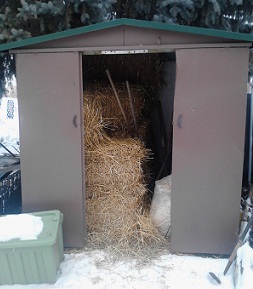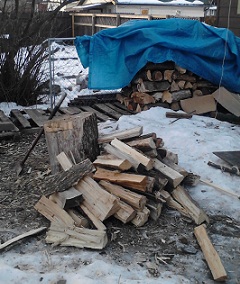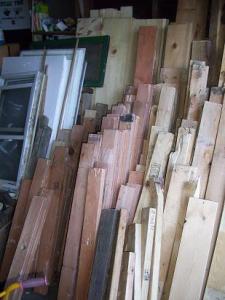In the first installment of the Urban Homesteading in a Northern Climate series, we talked about the garden and some tactics and ideas that can lead to successful food production. This week I want to continue that conversation by staying outside, and talk more about the other out-of-door spaces of a northern climate urban homestead.
It is easy for the garden to steal the show – they provide us with our sustenance, a place to escape to, and inspiration for songs and stories. It is more difficult to find that same spirit in a wood pile or a garden shed, but does it make these other aspects of our homesteads any less important? Certainly not!
Like the human body, a healthy, functioning homestead has many different parts and systems that complete the whole. Where the gardens and orchard may be the heart and circulatory system, our houses as our protective skin, and the kitchen as our digestive tract, all homesteads – like our bodies, require the basics to sustain life. These analogies of the body and a homestead are not perfect, but I do believe they do a decent job of illustrating the point I am trying to make.
So what are some of the other out door spaces that contribute to a healthy and vibrant homestead? What are their roles and more importantly, since we are talking about the Urban Homestead here, how do we design them into the small spaces we have to work with?
Let’s begin with an important piece of any homestead, the compost pile. If you are anything like me, the compost pile may be as important as the garden itself is. Without a place to turn our organic wastes into useful fertilizer and soil amendments, we wouldn’t have fertile, thriving gardens. We have our main compost pile located almost centered on our ½ acre plot. We use a system of two plastic compost bins (along with temporary welded – wire compost cages to accommodate seasonal over flow of compostable material), which cycle, and compost organic waste in a rotation of first in, first out. Because our homestead has been evolving over the last ten years, there are definite design flaws that we try to remedy as they are identified and as time permits.
One of these design flaws has to do with the interaction of our flock of backyard hens, and our compost area. Our number one compost ingredient is bedding straw and chicken manure. It would then make sense to have the chicken coop located in closer proximity to the compost area, or the other way around – but we don’t. The coop sits about 35 feet from the composting area, which really isn’t that far, but it is far enough when you are hauling bedding straw and chicken manure to be composted, and when you have limited space to utilize. This design flaw will hopefully be corrected this coming spring as we have plans to move the chicken coop and run right next to the composting area.
Another big advantage we will gain by moving the chickens closer to the compost area is that they will also be much closer to where we have one of our garden sheds located. This rickety old shed acts as a garden tool storage area, and where we store all of our fresh bedding straw. When we buy bales of straw from the farm supply store, we purchase upwards of 15 bales at a time for three reasons – we get a price break at that amount, we only drive down to the farm store 2 – 3 times a year (for bulk, raw grains for chicken feed, and straw), and because that is how many bales of straw my trailer can accommodate in one load.
With the erratic weather patterns and the on going drought that America has been dealing with for the last few seasons, having a place to securely store an expensive input like straw is important. While we don’t run a huge operation, knowing that we have 6 months to a years worth of straw stored in a dry place saves us money and time, and also adds a small bit of resilience to our homestead. I’d rather not import and spend money on a product like straw, but the simple fact is that I have too for right now, so having the infrastructure to properly store such a great source of compostable carbon is vital – even if it is a rusty old shed!
Continuing on the importance of outbuildings, we have one other shed, and a detached garage that are a part of our homestead. In the urban setting, a garage and/or sheds can help take the place of barns, machine/work shops, corn cribs, and granaries. Once again, here at The Dead End Alley Urban Farm (the commercial arm of the Autonomy Acres blog) we have another design flaw. This one though is not so much a flaw on the location or the structure itself, but of operator error! I am a collector of “useful materials”, or a less sexy way of putting it, a modern day scavenger! My habit of finding and then diving into dumpsters (or spotting cool stuff along boulevards) has yielded me vast amounts of lumber, fencing, firewood, windows, 55 gallon barrels, and many other useful, and random pieces of urban “waste”. Because of this, our small garage, two sheds, and yard have turned into a BIG mess!
I am not ready to abandon my habit of picking up useful materials, but I do have to figure out better ways of storing the materials I collect. Another project on the “to–do” list is to organize all the lumber and other random materials I have collected, and store them in ways that make them easy to inventory and even more easy to utilize and build with! If this can be accomplished, I can actually turn my small garage into a workshop that can then be used for making hive bodies and other beekeeping equipment, rain barrels, compost tumblers, and other DIY projects that I have going on or want to start!
Moving away from outbuildings, but staying on the theme of utilizing the urban “waste stream”, is fire wood. For the last two years, and periodically over the last decade, I have been able to heat my house with wood scavenged from neighbors’ yards, storm damaged trees left on the cities’ boulevards, the county compost site, and trees cut from my own land. In a typical Minnesota winter, that equals a lot of wood – at least two full cords of split, dried, and stacked firewood per winter season. Now this is one place where our design is almost perfect! Our spot for storing and chopping wood that is ready to burn is right out our back door (this same spot also doubles as an area to hang clothes out to dry in the summer!).
As funny as it sounds, this is one of my favorite out door spots in the winter. There is something about heating my house with wood that helps me keep in contact with the Earth and the realities of human comfort. I love the feel of the ax or the splitting maul in my hands as I chop wood, and I like knowing that MY physical labor not only helps to keep me a bit healthier, but also helps to keep my wife and kids warm when it is cold outside. One improvement that could be made however, and will be once time allows (surprise, surprise!), is adding some kind of semi – permanent, roofed structure to help shelter our firewood. Currently it is just covered with a tarp, but by having a real roof to protect it, we not only benefit from dry firewood, we also add another roof surface to collect rain water from!
Everything covered so far is really only the tip of the iceberg as far as outdoor spaces are concerned. The possibilities are endless when it comes to designing and implementing ideas for our outdoor spaces! This is a topic that whole books could be written about, so one blog post does not do this subject justice. Other areas of importance that all homesteads should at least consider and implement when practical and possible are spots dedicated to catching and collecting rain water, sites for grey water systems, areas for livestock – chickens, rabbits, goats, bees, etc…, summer kitchens (cob and masonry wood fired ovens, solar ovens, and rocket stoves come to mind – oh yeah, and a place to BBQ and smoke meat), areas for drying and curing produce, out door bathroom facilities including composting toilets and solar showers, and entertainment spots like decks, porches, an area for a bonfire pit and even a bit of a lawn for playing bocce ball!
Just like everyone’s body is a bit different, every homestead is unique. Where we live and what our interests are will play a big role in how we design and setup our outdoor spaces. Obviously if you live in a spot like southern California or Florida (or some other equivalent warm climate), heating your house in the winter is not going to be a big priority, and if you really aren’t into keeping bees or other livestock you won’t have to work that into your design either. But as homesteaders – whether in warm climates or cold, in the country or the city; it is our similarities that connect us, and lead to our ultimate success. So while it is the outside land where we grow our food, raise our animals, and store building and other such materials, it is the home that brings it altogether! And that is where we will pick up this conversation next time we talk about the Urban Homestead in a Northern Climate – The Home…. Peace & Cheers!



















